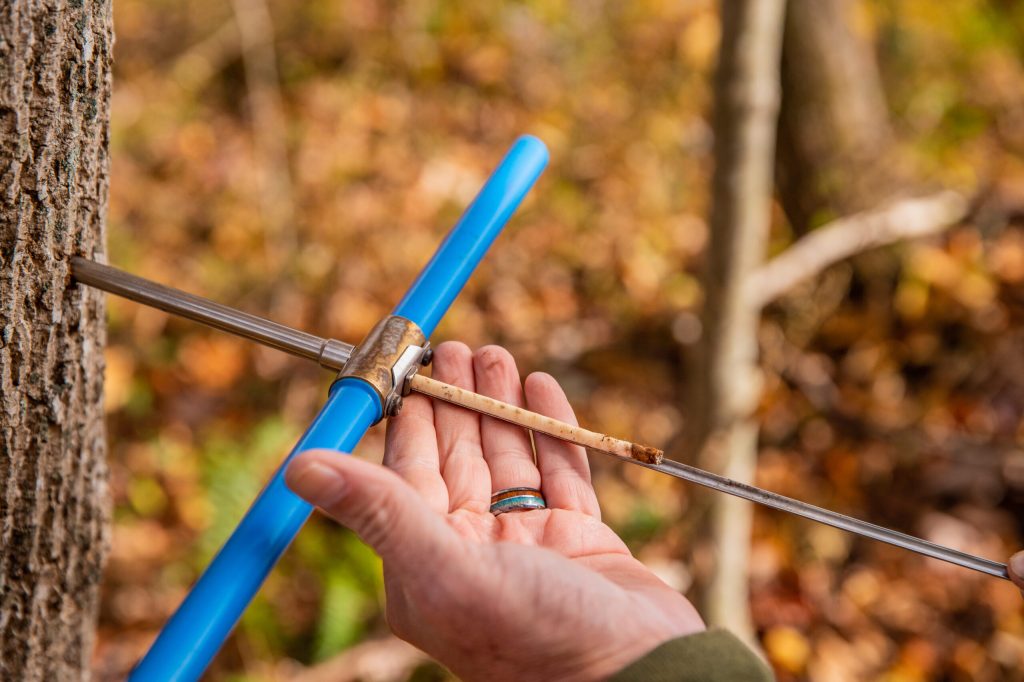‘Lungs of the state:’ Forestry program aims for smaller owners, sustainability
Published 3:09 pm Wednesday, May 29, 2024

- A forester measures a tree in Kentucky. (Mike Wilkinson/Wilkinson Visual)
Nearly three-fourths of Kentucky’s forests are held in smaller, family-owned lands. Until recently, most of these smaller acreage lands were cut off from carbon markets.
Until March, when a partnership between The Nature Conservancy and American Forest Foundation aimed to help family forest owners expanded into Kentucky.
The Family Forest Carbon Program allows small forest landowners to enroll their property into carbon markets, typically limited to forests exceeding 2,000 acres.
As the impacts of climate change become more tangible – hotter summers, more frequent intense weather events – the program aims to reach smaller, but just as important, corners of America’s forests.
How does the Family Forest Carbon Program work?
Forest landowners with as few as 30 acres can enter the program. Upon acceptance, landowners will work to identify their goals for their land.
Then, expert foresters will create a customized forest management plan aligned with the landowner’s goals and sustainability.
Ian Forte, senior forestry manager for the American Forest Foundation’s southern Appalachian region, said sometimes private landowners don’t know how to manage their land but want to do what’s right for the environment and the forest’s health.
FFCP foresters work with local experts who know the forests best to craft management plans. Foresters measure timber, see what types are present in the forest, gather historical land management data and compile all the information into a customized plan.
Over the 20-year contracts, landowners get two plans.
The program is designed to allow landowners to harvest timber when they want, but make sure they leave something behind so the forest can regenerate.
This differs from some traditional forestry techniques like high-grading, which takes all the best timber at once for harvest to maximize profit, leaving behind bad genetics and room for invasive species and pests to enter, Forte said.
The program allows owners to harvest up to a quarter of the total basal area, compared to 60-70% in less sustainable forestry practices.
Carbon markets and sequestration
The Nature Conservancy and the American Forest Foundation introduced a new technology to measure carbon sequestration for this program.
It’s called a dynamic baselines approach, and measures something called additionality, said Sean Bowers, TNC Central Appalachians forester.
“Additionality is, is the carbon generated from this project because of the project or would it have happened without the project being on that land?” Bowers said.
Foresters compare the forest to the 10 most similar woodlands in the region not in the program and use those as a baseline.
The result is a more accurate measure of how much forest management practices are actually contributing to the effort to mitigate climate change by removing carbon dioxide from the atmosphere.
By using these measures, landowners produce higher integrity carbon credits they can sell to companies trying to offset their own emissions.
FFCP is part of the voluntary carbon market, which includes companies who are not legally required to offset emissions but are making a voluntary commitment to show their commitment to sustainability, Bowers said.
Why is the Family Forest Carbon Program important?
Kentucky’s forests are the “lungs of the state,” Bowers said. They are fairly subdivided into smaller parcels, but together, have the potential to make an impact.
Human development, forest usage and some improper management has restricted natural forest processes and allowed invasive species to come in, Bowers said.
Forte agreed, noting that these invasive species have prevented forest regeneration, and a too-high deer population has hindered the growth of saplings.
“If there was a disease, storm damage, tornado, whatever the case might be, that comes in, knocks off the mature trees, there’s just nothing there to regenerate,” Forte said.
Through the program, landowners are able to collect a small but reliable income that gives them more space to manage their forests in a future-minded way instead of an entirely profit-focused way.
The Family Forest Carbon Program aims to enroll a fifth of the nation’s family-owned forest acres in climate-friendly practices by 2030. This would offset about 50 million tons of carbon and its equivalents every year.
So far, the program has enrolled about 80,000 acres of the nation’s 290 million acres with the help of about 500 landowners. But it’s just getting started. Later this year, the program will expand in four new states, adding to a total of 19 states.

